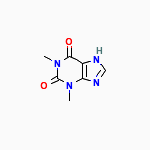

Cas No. [58-55-9]
Leading manufacturers of Theophylline and its
derivatives in India.
| Name |
: |
Theophylline |
| CAS # |
: |
[58-55-9] |
| End Use |
: |
Bronchodilator |
IUPAC Name:
1,3-dimethyl-7H-purine-2,6-dione | CAS Registry Number: 58-55-9
Synonyms: theophylline, Elixophyllin, Theophyllin, Theolair, Theocin,
Nuelin, Synophylate, Bronkodyl, Aerolate, Theovent, Respbid, Theobid,
Uniphyl, 1,3-Dimethylxanthine, Pseudotheophylline, aminophylline,
Slo-phyllin, Elixophylline, Liquophylline, Armophylline
| Molecular Formula: |
C7H8N4O2 |
Molecular Weight: |
180.164020 [g/mol] |
| H-Bond Donor: |
1 |
H-Bond Acceptor: |
4 |
A methyl xanthine derivative from tea with diuretic,
smooth muscle relaxant, bronchial dilation, cardiac and central nervous
system stimulant activities. Theophylline inhibits the 3',5'-CYCLIC
NUCLEOTIDE PHOSPHODIESTERASE that degrades CYCLIC AMP thus potentiates
the actions of agents that act through ADENYLATE CYCLASE and cyclic AM
DRUG CLASS AND MECHANISM:
Theophylline belongs to a class of medications called bronchodilators,
used in treating
asthma and other airway
diseases.
Asthma is a breathing problem
involving narrowing of the airways. Airways are breathing passages that
allow air to move in and out of the lungs. Airways can be narrowed due
to accumulation of mucus, spasm of the muscles that surround these
airways, or swelling of the lining of the airways. Airway narrowing
leads to symptoms of shortness of breath, wheezing, cough and
congestion. The narrowed airways can open either spontaneously or from
medications. Medications that open airways are called bronchodilators.
Theophylline opens airways by relaxing the smooth muscles in the walls
of the airways. Theophylline can also be helpful in patients with
emphysema and
chronic bronchitis when their
symptoms are partially related to reversible airway narrowing.
Theophylline also strengthens right heart function and diaphragm
movement.
The main actions of theophylline
involve:
• relaxing bronchial
smooth muscle
• increasing heart muscle
contractility and efficiency: positive inotropic
• increasing heart rate:
positive chronotropic
• increasing blood
pressure
• increasing renal blood
flow
• some anti-inflammatory
effects
• central nervous system
stimulatory effect mainly on the medullary respiratory center.
History
Theophylline was first extracted
from tea leaves and chemically identified around 1888 by the German
biologist Albrecht Kossel.Just seven years after its discovery, a
chemical synthesis starting with 1,3-dimethyluric acid was described by
Emil Fischer and Lorenz Ach. The Traube synthesis, an alternative method
to synthesize Theophylline has been introduced in 1900 by another German
scientist, Wilhelm Traube. Theophylline's first clinical use came in
1902 as diuretic.It took additional 20 years until its first description
in asthma treatment.
Pharmacokinetics
Absorption
Bioavailability is 100%. However,
taking the drug late in the evening may slow the absorption process,
without affecting the bioavailability. Taking the drug after a meal high
in fat content will also slow down the absorption process, without
affecting the bioavailability.
Distribution
Theophylline is distributed in the
extracellular fluid, in the placenta, in the mother's milk and in the
central nervous system. The volume of distribution is 0.5 L/kg. The
protein binding is 40%. The volume of distribution may increase in
neonates and those suffering from cirrhosis or malnutrition, whereas the
volume of distribution may decrease in those suffering from obesity.
Metabolism
Theophylline is metabolized
extensively in the liver (up to 70%). It undergoes N-demethylation via
cytochrome P450 1A2. It is metabolized by parallel first order and
Michaelis-Menten pathways. Metabolism may become saturated (non-linear),
even within the therapeutic range. Small dose increases may result in
disproportionately large increases in serum concentration. Methylation
in Theophylline is also important in the infant population. Smokers and
people with hepatic (liver) impairment metabolize it differently.
Elimination
Theophylline is excreted unchanged
in the urine (up to 10%). Clearance of the drug is increased in these
conditions: children 1 to 12, teenagers 12 to 16, adult smokers, elderly
smokers, cystic fibrosis, hyperthyroidism. Clearance of the drug is
decreased in these conditions: elderly, acute congestive heart failure,
cirrhosis, hypothyroidism and febrile viral illness.
The elimination half-life varies: 30
hours for premature neonates, 24 hours for neonates, 3.5 hours for
children ages 1 to 9, 8 hours for adult non-smokers, 5 hours for adult
smokers, 24 hours for those with hepatic impairment, 12 hours for those
with congestive heart failure NYHA class I-II, 24 hours for those with
congestive heart failure NYHA class III-IV, 12 hours for the elderly.
Indications
The main therapeutic uses of
theophylline are aimed at:
• chronic obstructive
pulmonary disease (COPD)
• asthma
• infant apnea
Uses Under Investigation
A clinical study reported in 2008
that theophylline was helpful in improving the sense of smell in study
subjects with anosmia.
Side-effects
The use of theophylline is
complicated by the fact that it interacts with various drugs, chiefly
cimetidine and phenytoin, and that it has a narrow therapeutic index, so
its use must be monitored to avoid toxicity. It can also cause nausea,
diarrhea, increase in heart rate, arrhythmias, and CNS excitation
(headaches, insomnia, irritability, dizziness and lightheadedness). Its
toxicity is increased by erythromycin, cimetidine, and fluoroquinolones,
such as "cipro" (ciprofloxacin). It can reach toxic levels when taken
with fatty meals, an effect called dose dumping.
|












